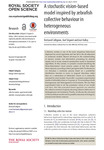A stochastic vision-based model inspired by zebrafish collective behaviour in heterogeneous environments
| dc.contributor.author | Collignon, Bertrand | en_US |
| dc.contributor.author | Séguret, Axel | en_US |
| dc.contributor.author | Halloy, José | en_US |
| dc.date.accessioned | 2016-10-11T05:37:11Z | |
| dc.date.available | 2016-10-11T05:37:11Z | |
| dc.date.issued | 2016 | en_US |
| dc.identifier.other | HPU4160654 | en_US |
| dc.identifier.uri | https://lib.hpu.edu.vn/handle/123456789/23543 | |
| dc.description.abstract | Collective motion is one of the most ubiquitous behaviours displayed by social organisms and has led to the development of numerous models. Recent advances in the understanding of sensory system and information processing by animals impels one to revise classical assumptions made in decisional algorithms. In this context, we present a model describing the three-dimensional visual sensory system of fish that adjust their trajectory according to their perception field. Furthermore, we introduce a stochastic process based on a probability distribution function to move in targeted directions rather than on a summation of influential vectors as is classically assumed by most models. | en_US |
| dc.format.extent | 17 p. | en_US |
| dc.format.mimetype | application/pdf | |
| dc.language.iso | en | en_US |
| dc.subject | Biology | en_US |
| dc.subject | Computational biology | en_US |
| dc.subject | Behaviour | en_US |
| dc.subject | Theoretical biology | en_US |
| dc.subject | Collectivemotion | en_US |
| dc.subject | Agent-basedmodel | en_US |
| dc.subject | Zebrafish | en_US |
| dc.subject | Visual perception | en_US |
| dc.subject | Solid angle | en_US |
| dc.title | A stochastic vision-based model inspired by zebrafish collective behaviour in heterogeneous environments | en_US |
| dc.type | Article | en_US |
| dc.size | 1.35MB | en_US |
| dc.department | Education | en_US |
Files in this item
This item appears in the following Collection(s)
-
Education [806]

